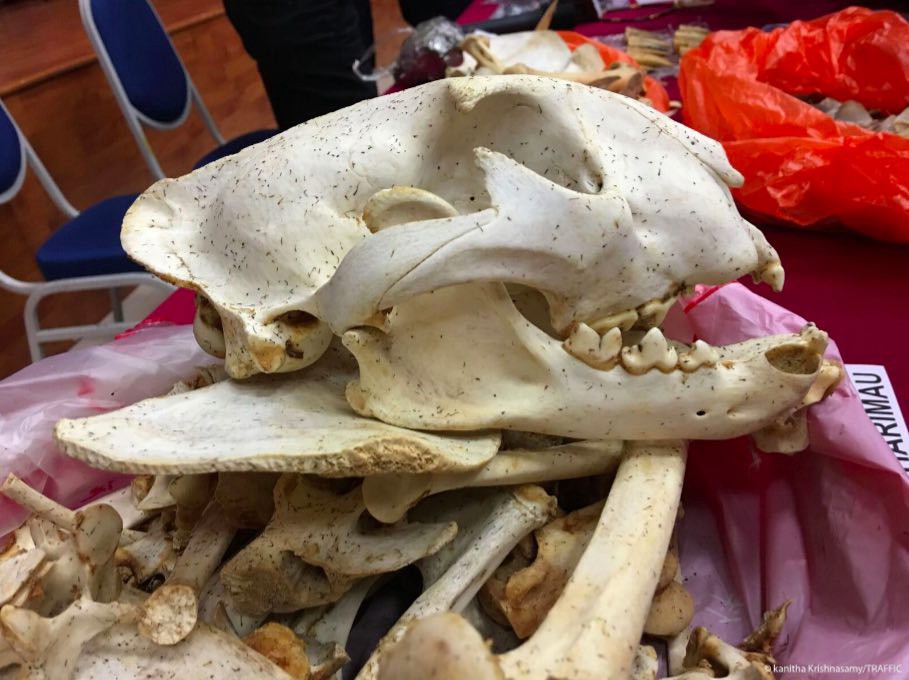Between 2000 and 2015, a total of 801 tiger seizures — equivalent to at least 1,755 tigers — were reported across 13 tiger range countries, with the number of tiger seizures increasing over the years, according to a new report.
By Shreya Dasgupta
This tiger skin was one of eight seized by authorities in Peninsular Malaysia in 2012. (Photo: E. John/TRAFFIC)
Tiger poaching is showing no sign of slowing down, according to a new report by TRAFFIC, the wildlife trade monitoring network.
Between 2000 and 2015, a total of 801 tiger seizures — equivalent to at least 1,755 tigers — were reported across 13 tiger range countries, the report has found. This is indicative of a minimum of 110 tigers being seized annually or more than two tigers being seized every week.
“This analysis provides clear evidence that illegal trade in tigers, their parts and products, persists as an important conservation concern,” Steven Broad, executive director of TRAFFIC, said in a statement. “Despite repeated government commitments to close down tiger farms in Asia, such facilities are flourishing and playing an increasing role in fueling illegal trade.”
Analysis of the trafficking data revealed that both the number of reported tiger seizures, as well as the minimum number of tigers being traded appears to be increasing every year. This increasing trend could be indicative of improved reporting practices or more effective law enforcement efforts rather than an actual increase in crime levels. But it is still a big cause for concern, conservationists say.
At least 297 of the 1,755 tigers seized during the 16-year period reportedly originated from a captive facility such as a tiger farm, zoo or a tourist facility.
This is because tigers have been extirpated from across most of their previous range. Only 3,000 to 4,000 tigers are estimated to survive in the wild, while more than 7,000 to 8,000 tigers are believed to occur in captivity in Asia.
Among the tiger range countries, India reported the highest number of tiger seizures — about 355 — during the 16-year period. While the seizures appear to have declined over the years, this may be due to gaps in data and may not represent an actual decrease, the report notes.
During the same time period, tiger seizures in Thailand and Vietnam increased. Thailand, for example, seized 166 tigers between 2012 and 2015, up from 64 tigers seized between 2008 and 2011. This steep rise can be attributed to the 100 tigers seized from Thailand’s infamous “Tiger temple” in 2015, indicating an increasing role of tigers and tiger parts sourced from captivity in the illegal tiger trade. In fact, at least 297 of the 1,755 tigers seized during the 16-year period reportedly originated from a captive facility such as a tiger farm, zoo, or a tourist facility, according to the report.
All tigers are listed in the Appendix I of CITES, which means commercial trade in tigers or tiger parts and products are banned. However, illegal trade continues, largely due to loopholes in domestic laws that allow both wild and captive-sourced tigers to be trafficked, as well as ineffective law enforcement efforts. Conservationists fear that captive facilities could also be fueling tiger trafficking by increasing the desirability and demand of tiger products.

This tiger skull and bones were among several tiger parts seized in a series of raids in Peninsular Malaysia in 2016. (Photo: Kanitha Krishnasamy/TRAFFIC)
“Criminal networks are increasingly trafficking captive bred tigers around Asia, undermining law enforcement efforts and helping to fuel demand,” Ginette Hemley, head of the CITES delegation from the World Wildlife Fund, said in the statement. “Tiger range countries must rapidly close their farms or wild tigers will face a future only as skin and bones.”
In a positive move welcomed by conservationists, Lao PDR announced last week that it would begin “phasing out its tiger farms.”
To curb tiger poaching, the report urges the tiger range countries to share information and intelligence of tiger seizures and poaching incidences. India, for instance, has asked other governments at CoP17 to share photographs of seized tiger skins. Comparing the stripe patterns on these skins with camera trap images of wild tigers held in India’s database could help enforcement agencies identify the origin of poached tigers.
The report also points out the increasing role of the Internet and social media in enabling the illegal tiger trade, and urges “commercial trading sites and social media enterprises to work closely with national governments to shut down businesses and individuals found to be facilitating the illegal trade in tigers (and other endangered species) online.”
This story originally appeared at the website of global conservation news service Mongabay.com. Get updates on their stories delivered to your inbox, or follow @Mongabay on Facebook, Instagram, or Twitter.





